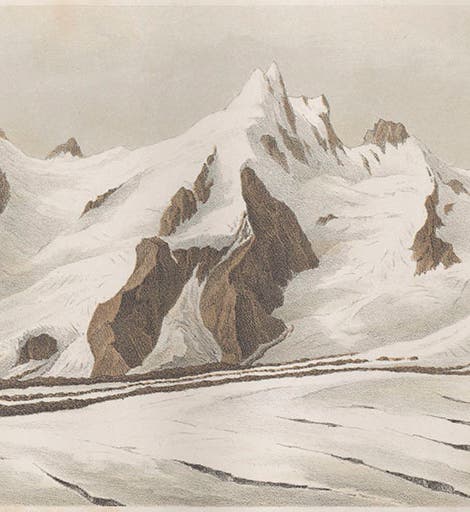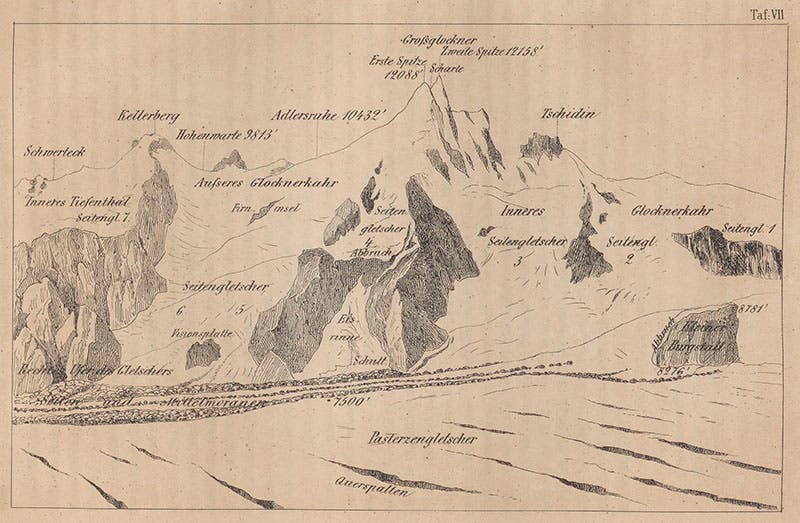Scientist of the Day - Adolph von Schlaginweit
Adolph von Schlagintweit, a German naturalist and explorer, was born Jan. 9, 1829. In 1846, he and his older brother Hermann set off to explore the Alps. Very much inspired by Alexander von Humboldt and his emphasis on the importance of measurement when exploring, they took along a variety of specialized instruments, such as a eudiometer (for measuring the 'goodness' of the air at altitude), and a cyanometer (for measuring the "blueness" of the sky); many of these instrumenets were pictured in one of the plates of their ensuing book (fifth image). We discussed the origin of the cyanometer in a previous post, which you may consult, provided you take note of the date of the posting, April 1, 2018.
Adolph and Hermann spent two years on their expedition and returned to publish Untersuchungen über die physikalische Geographie der Alpen (Studies on the Physical Geography of he Alps), which brought them into prominence as scientific explorers. Their book was printed by the noted Leipzig publisher of geographical books, J.A. Barth, and it contains 13 splendid chromolithographs, which means the color was printed rather than being added by hand. Several plates depict mountain peaks and their glaciers; we show one that illustrates the Grossglockner in the Austrian Alps (first image). Each of the views was accompanied by a facing page that provided outlines of the topography on the plate opposite with added labels for everything (third image). Swiss geologist Louis Agassiz pioneered this technique in his 1840 book Études sur les glaciers, although in Agassiz's book, the diagrams were overlays.
The Schlagintweit brothers also included several graphically informative diagrams in their book, very much in the Humboldt style; one, for example, correlated the seasonal temperatures on a variety of Alpine mountains with the help of isothermal lines (fourth image).
Our copy of the Untersuchungen is rather special, for it was a presentation copy from the Schlagintweit brothers to John Herschel, the eminent British astronomer and philosopher. It came to us when we purchased a number of books from Herschel's Library in 2000, through the auspices of London bookseller Simon Finch. The inscription on the free endpaper reads: "To Sir John Herschel, Bart Ac. Ac. as a mark of highest esteem and most sincere admiration, from the authors Dr Herm. Schlagintweit, Dr Adolph Schlagintweit. London, Dec. 2nd 1850" (sixth image).
Adolph, along with Hermann and younger brother Robert, would undertake another expedition in 1854, this time to India and the Himalayas. Robert and Hermann returned in 1857 to publish a four-volume account of these adventures, Reisen in Indien und Hochasien (Travels to India and High-Asia), 1869-80. Unfortunately, Adolph did not return. While in Kashgar, he was accused by the local khan of being a spy for China and was summarily beheaded. In a bizarre sequence of events, Adolph’s head survived and was brought back to Europe in 1859. The return of the head was supposedly one source of inspiration for Rudyard Kipling’s The Man Who Would be King (1888).
Our copy of Travels to India is about as incomplete as a work can be and still be in the collection – we have only volume 4, which is why we chose to focus on the earlier book. Fortunately, our lonesome volume has a splendid lithograph portrait of Adolph, which we use to close this post (seventh image).
Dr. William B. Ashworth, Jr., Consultant for the History of Science, Linda Hall Library and Associate Professor emeritus, Department of History, University of Missouri-Kansas City. Comments or corrections are welcome; please direct to ashworthw@umkc.edu.











![Columbine, hand-colored woodcut, [Gart der Gesundheit], printed by Peter Schoeffer, Mainz, chap. 162, 1485 (Linda Hall Library)](https://assets-us-01.kc-usercontent.com:443/9dd25524-761a-000d-d79f-86a5086d4774/3829b99e-a030-4a36-8bdd-27295454c30c/gart1.jpg?w=210&h=210&auto=format&fit=crop)
